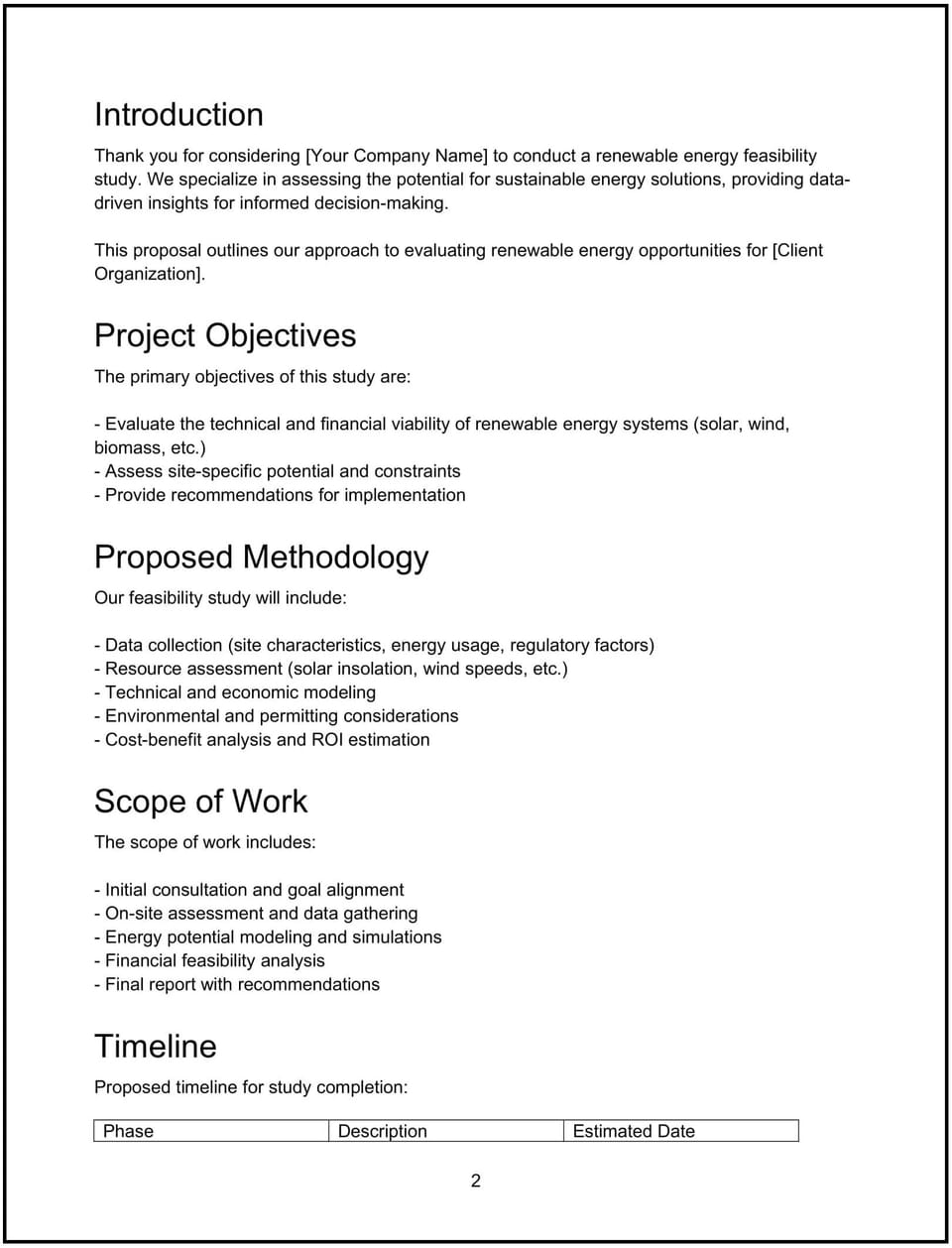Renewable energy feasibility study proposal: Free template

Renewable energy feasibility study proposal: Free template
Customize this free renewable energy feasibility study proposal with Cobrief
Open this free renewable energy feasibility study proposal in Cobrief and start editing it instantly using AI. You can adjust the tone, structure, and content based on the project scope, location, and energy source. You can also use AI to review your draft — spot gaps, tighten language, and improve clarity before sending.
Once you're done, send, download, or save the proposal in one click — no formatting or setup required.
This template is fully customizable and built for real-world use — ideal for proposing solar, wind, or hybrid energy studies, responding to government or private RFPs, or guiding infrastructure planning. Whether you’re working with developers, municipalities, or corporate clients, this version gives you a structured head start and removes the guesswork.
What is a renewable energy feasibility study proposal?
A renewable energy feasibility study proposal outlines how you'll evaluate the potential for installing and operating a renewable energy system at a specific site. It typically covers the project scope, methodology, timelines, data requirements, and estimated costs for the study.
Use this proposal to:
- Define the process for assessing solar, wind, geothermal, or hybrid systems
- Provide a structured plan for site evaluation, modeling, and analysis
- Clarify deliverables like reports, recommendations, and ROI projections
- Build trust with clients by showing your technical and regulatory expertise
This type of proposal is commonly used by energy consultants, engineering firms, and environmental planners. It’s often submitted before formal project design or funding approval.
Why use Cobrief to edit your proposal
- Edit the full proposal instantly: No uploading or formatting — open and start editing in-browser.
- Use AI to adapt your methodology or scope: Tailor the content to match the client’s site, goals, or energy type.
- Run an AI-powered review: Identify unclear language, missing phases, or weak assumptions.
- Apply AI suggestions in one click: Accept edits individually or all at once.
- Save, send, or download in seconds: Share a clean proposal as a link, email, or downloadable PDF.
When to use this proposal
- When responding to a government or NGO request for a feasibility study: Submit a structured approach with pricing and deliverables.
- When pitching a study for a private site or facility: Show how you’ll assess renewable energy potential and return on investment.
- When working with real estate or infrastructure developers: Propose pre-installation analysis for solar, wind, or hybrid systems.
- When advising businesses on energy transition goals: Offer a roadmap for evaluating site viability and long-term energy savings.
- When helping clients access incentives or grants: Provide a formal study plan required for funding or compliance.
What to include in a renewable energy feasibility study proposal
- Project overview: A brief summary of the site, client goals, and energy sources being considered.
- Study objectives: Clear goals such as estimating energy output, financial viability, or regulatory fit.
- Methodology: Step-by-step breakdown of how the study will be conducted — site visit, modeling, data analysis, etc.
- Scope of work: Detailed list of activities and deliverables — e.g., resource assessment, load analysis, financial modeling.
- Timeline: Project duration with key milestones, from kickoff to final report delivery.
- Team and experience: Short bios or credentials of key personnel, plus examples of similar studies completed.
- Pricing: Fixed fee or phased pricing for the full scope of work.
- Next steps: A call to action — such as scheduling a site assessment, approving the proposal, or initiating a contract.
How to write an effective renewable energy feasibility study proposal
- Anchor the study to business or policy goals: Show how the analysis will support decision-making — not just gather data.
- Use plain language for technical concepts: Make the methodology understandable to both technical and non-technical stakeholders.
- Highlight similar work: Reference past studies, especially if they led to funded or implemented projects.
- Be clear about assumptions and limitations: Avoid overstating potential benefits — clients appreciate honesty.
- Break down deliverables by phase: Help the client see exactly what they’re getting at each step.
- End with a confident next step: Make it easy for the client to take action — whether it’s a site visit, kickoff call, or contract review.
Frequently asked questions (FAQs)
Can I customize this for different energy types like solar, wind, or geothermal?
Yes — this proposal is fully editable, so you can tailor it to any renewable energy source or combination.
Is this suitable for public sector or grant-funded projects?
Absolutely. You can include compliance, funding criteria, or specific deliverables required for public projects.
Can I change the scope depending on the site size?
Yes — the template is flexible and works for both small facilities and large-scale projects.
Can I export this proposal as a branded PDF?
Yes — once you’ve edited the proposal, you can download a professional PDF instantly.
This article contains general legal information and does not contain legal advice. Cobrief is not a law firm or a substitute for an attorney or law firm. The law is complex and changes often. For legal advice, please ask a lawyer.